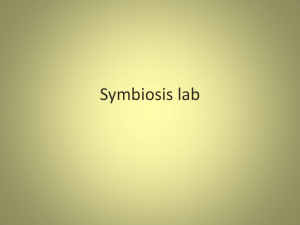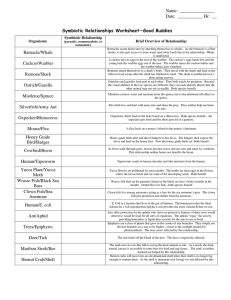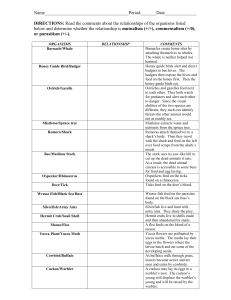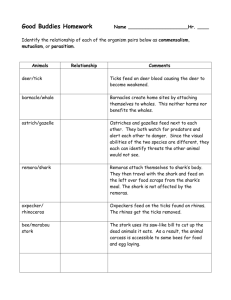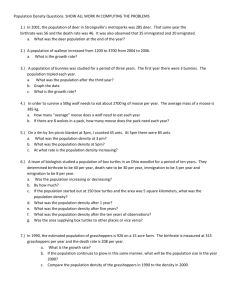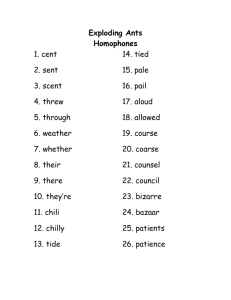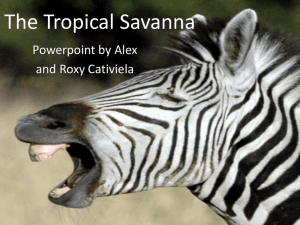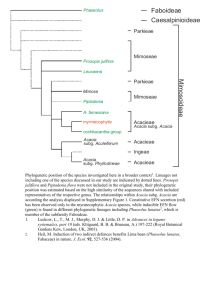Worksheet - COACH JANOWIAK
advertisement
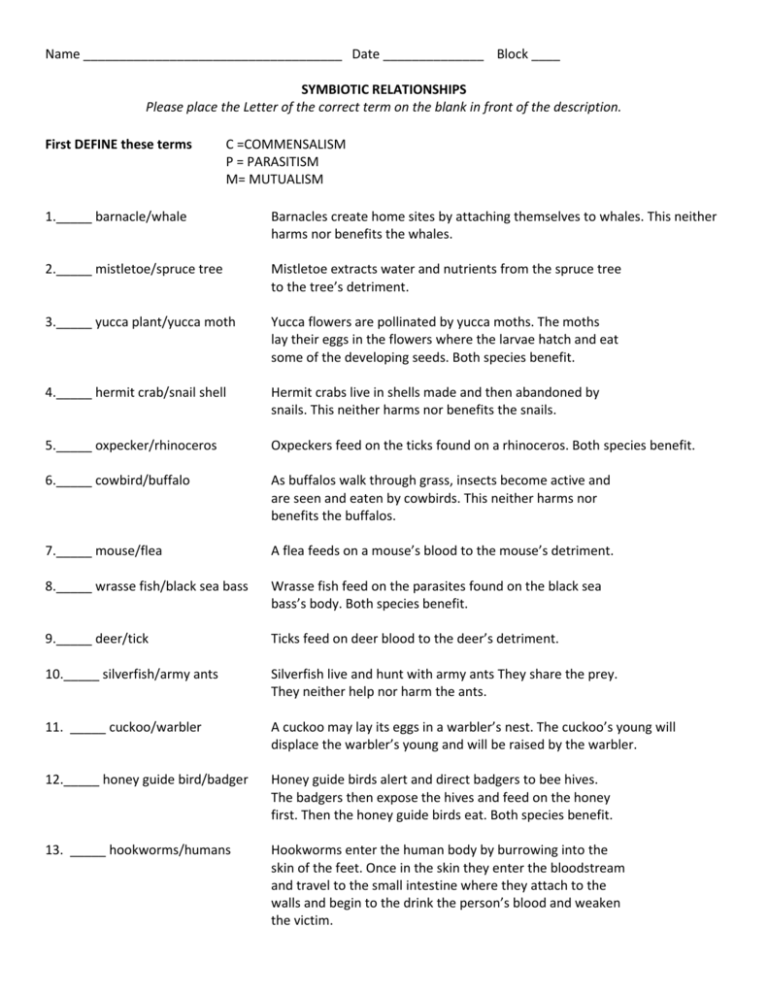
Name ____________________________________ Date ______________ Block ____ SYMBIOTIC RELATIONSHIPS Please place the Letter of the correct term on the blank in front of the description. First DEFINE these terms C =COMMENSALISM P = PARASITISM M= MUTUALISM 1._____ barnacle/whale Barnacles create home sites by attaching themselves to whales. This neither harms nor benefits the whales. 2._____ mistletoe/spruce tree Mistletoe extracts water and nutrients from the spruce tree to the tree’s detriment. 3._____ yucca plant/yucca moth Yucca flowers are pollinated by yucca moths. The moths lay their eggs in the flowers where the larvae hatch and eat some of the developing seeds. Both species benefit. 4._____ hermit crab/snail shell Hermit crabs live in shells made and then abandoned by snails. This neither harms nor benefits the snails. 5._____ oxpecker/rhinoceros Oxpeckers feed on the ticks found on a rhinoceros. Both species benefit. 6._____ cowbird/buffalo As buffalos walk through grass, insects become active and are seen and eaten by cowbirds. This neither harms nor benefits the buffalos. 7._____ mouse/flea A flea feeds on a mouse’s blood to the mouse’s detriment. 8._____ wrasse fish/black sea bass Wrasse fish feed on the parasites found on the black sea bass’s body. Both species benefit. 9._____ deer/tick Ticks feed on deer blood to the deer’s detriment. 10._____ silverfish/army ants Silverfish live and hunt with army ants They share the prey. They neither help nor harm the ants. 11. _____ cuckoo/warbler A cuckoo may lay its eggs in a warbler’s nest. The cuckoo’s young will displace the warbler’s young and will be raised by the warbler. 12._____ honey guide bird/badger Honey guide birds alert and direct badgers to bee hives. The badgers then expose the hives and feed on the honey first. Then the honey guide birds eat. Both species benefit. 13. _____ hookworms/humans Hookworms enter the human body by burrowing into the skin of the feet. Once in the skin they enter the bloodstream and travel to the small intestine where they attach to the walls and begin to the drink the person’s blood and weaken the victim. 14_____ kapoc trees/orchids Types of orchids grow high on the branches of the tall kapoc trees of the jungle. This adaptation allows the orchid to receive enough sunlight to perform its photosynthesis but the kapoc trees are unaffected. 15._____ lichen algae/lichen fungus Lichens are close associations of fungi and algae. The fungi hold the water supply and the algae perform photosynthesis and manufacture the carbohydrates for both. 16._____ acacia tree/ants In the jungles of South America live a thorn tree called an acacia. A species of ant eats secretions of the acacia, drink its sap, and raise its young in the hollow thorns. The ants also keep competing vines from growing near the acacia tree and they help repel any insects that would damage the acacia. 17. _____ moose/tapeworm In the flesh of the moose are the cysts (dormant stage) of a worm that makes the muscles of the moose stiff and sore. If the moose is killed and eaten raw, the predator species will develop a form of tapeworm. 18. _____ lactobacilli/humans Lactobacilli are a type of bacteria that live in our lungs and destroy many of the microorganisms that enter our respiratory system. They are highly adapted to living in our lungs and can’t survive in many other habitats. 19. _____ soybeans/bacteria Soybeans require nitrogen from their environment. This nitrogen is provided by bacteria that live in special root nodules. In return, the bacteria receive some of the sugar (carbohydrates) manufactured by the soybeans.
